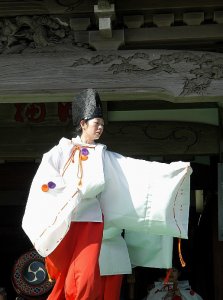Presented By: Center for Japanese Studies
CJS Noon Lecture Series
Ritual Song in Heian Japan: Shomyo and Shirabyoshi

A lecture by Makiko Sakurai, Shōmyō/Shirabyōshi Performer
See Makiko Sakurai in Performance
September 19, 5:30-7:30 pm, Helmut Stern Auditorium
The University of Michigan Museum of Art, 525 South State Street.
Makiko Sakurai: Songwriter/Vocalist (Tendai Ohara chant)/Performer (Shirabyoshi dance)
Mariko Sakurai has studied the Tendai Ohara style of shomyo with Genshin Nakayama since 1989. She received her undergraduate degree from Osaka University of the Arts in piano performance and a master’s degree in composition from Tokyo College of Music. In 1994 she received a scholarship from the Asian Culture Council to study the Navajo language and the music of the Navajo and the Hopi in Arizona. Following this study, she returned to the performance of Heian period chant and shirabyoshi dance in its unaccompanied form. Ms. Sakurai has adapted shomyo for contemporary settings, collaborated with Japanese and American composers, and written several original noh dramas, including Manhattan Okina (first performed 2007), Pirate Princess (2009), and Minister of the Bank (2014).
Abstract: Shomyo is a chant used in Japanese esoteric Buddhist services. This talk will introduce shomyo in the Tendai sect. Tendai shomyo was brought to Japan from China by the monk Ennin (794-864). Initially, during the Heian period (8th-12th centuries CE), the monks chanted the poetic parts of sutra text in Chinese or Sanskrit. Later, monks began to chant the translated Japanese text. A Buddhist service conducted in translated Japanese is called renji, and the part of renji that is sung is called shirabyoshi. Later the word shirabyoshi came to refer also to female performers who sung Buddhist and Chinese literary texts. These performers also danced. This talk will introduce shomyo and shirabyoshi and discuss their transformation over time.
Cosponsored by the Center for World Performance Studies, the Confucius Institute at the University of Michigan, the Department of Musicology, and the Kenneth G. Lieberthal and Richard H. Rogel Center for Chinese Studies.
See Makiko Sakurai in Performance
September 19, 5:30-7:30 pm, Helmut Stern Auditorium
The University of Michigan Museum of Art, 525 South State Street.
Makiko Sakurai: Songwriter/Vocalist (Tendai Ohara chant)/Performer (Shirabyoshi dance)
Mariko Sakurai has studied the Tendai Ohara style of shomyo with Genshin Nakayama since 1989. She received her undergraduate degree from Osaka University of the Arts in piano performance and a master’s degree in composition from Tokyo College of Music. In 1994 she received a scholarship from the Asian Culture Council to study the Navajo language and the music of the Navajo and the Hopi in Arizona. Following this study, she returned to the performance of Heian period chant and shirabyoshi dance in its unaccompanied form. Ms. Sakurai has adapted shomyo for contemporary settings, collaborated with Japanese and American composers, and written several original noh dramas, including Manhattan Okina (first performed 2007), Pirate Princess (2009), and Minister of the Bank (2014).
Abstract: Shomyo is a chant used in Japanese esoteric Buddhist services. This talk will introduce shomyo in the Tendai sect. Tendai shomyo was brought to Japan from China by the monk Ennin (794-864). Initially, during the Heian period (8th-12th centuries CE), the monks chanted the poetic parts of sutra text in Chinese or Sanskrit. Later, monks began to chant the translated Japanese text. A Buddhist service conducted in translated Japanese is called renji, and the part of renji that is sung is called shirabyoshi. Later the word shirabyoshi came to refer also to female performers who sung Buddhist and Chinese literary texts. These performers also danced. This talk will introduce shomyo and shirabyoshi and discuss their transformation over time.
Cosponsored by the Center for World Performance Studies, the Confucius Institute at the University of Michigan, the Department of Musicology, and the Kenneth G. Lieberthal and Richard H. Rogel Center for Chinese Studies.
Explore Similar Events
-
Loading Similar Events...
